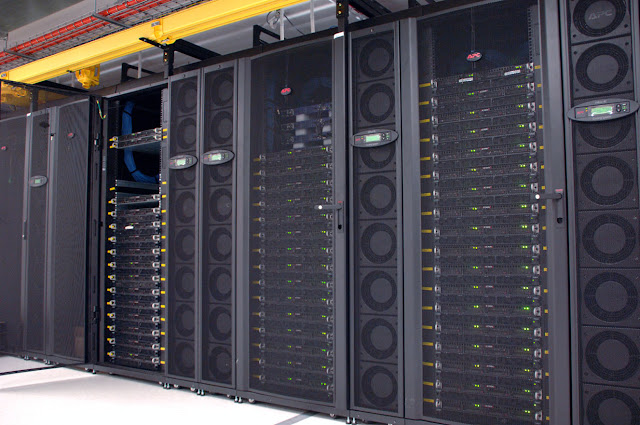October.29 (China Military News Reporting by Johnathan Weng) — The Chinese National University of Defense Technology (NUDT) unveiled Thursday China’s fastest supercomputer, also the World Third fastest computer, which is able to do more than one quadrillion calculations per second theoretically at its peak speed.
China name this supercomputer as “Tianhe-I” (天河一号 meaning River in Sky), which later will be installed in Tianjin. As matter of fact, Tianjin is one of two cities with “Super computing center”
China announces that “Tianhe-I”’s theoretical peak performance can reach 1.2 petaFLOPS and highest LINPACK score is 563.1 teraFLOPS. The rank of “Tianhe-I” peak performance has exceeded the JUGENE (1.0 petaFLOPS) of Jülich Research Centre and its LINPACK score overrun NASA’s Pleiades.
China says the birth of “Tianhe-1″ let China be the second country to develop petaFLOP level supercomputer beside U.S..
“Tianhe-I” has 6,144 Intel CPUs and 5,120 AMD GPUs, Total Memory is 98TB, point-to-point communication bandwidth is 40Gbps. “Tianhe-I” has 103 racks, weights 155 tons and occupies nearly 1,000 square metres. According to Chinese news resources, “Tianhe-I” will be used in computing the structures and properties of chemical compounds, biological macromolecules; physical simulations of airplanes and spaceships. China does not disclose whether this supercomputer will be used in military purposes, such as nuclear weapon development.
“Tianhe-I” has an Architecture of Vector processing Coordination Configurable Parallel System. “Tianhe-I” is one project of well-known “863 Plan” and was initiate in 2008.
Chinese National University of Defense Technology (NUDT) is also the developer of China’s first gigaFLOPS supercomputer “Yinhe”.
At present, the performance score has not been confirmed by Top500.org.
Here is a table of China’s supercomputer development histroy:
Fusion-io, a designer of high-end solid-state drive (SSD) solutions, announced this week that it would deploy custom installations based on its ioMemory technology at two presently undisclosed government organizations. Each deployment consists of hundreds of terabytes of solid-state storage capacity and is capable of sustaining over 1TB/s of aggregate bandwidth with access latencies under 50ms.
The extreme performance achievements were made possible by Fusion-io’s development of the ioDrive Octal card, a custom PCI Express card. The device holds eight ioMemory Modules – putting the equivalent capacity and performance of eight ioDrives into a single card. The ioDrive Octal fits any PCI Express 2.0 x16 double-wide slot, the same as those used for high performance graphics cards, and it is capable of saturating the full performance of that slot. The ioDrive Octal again demonstrates the flexibility, performance and scalability of Fusion’s ioMemory architecture, the core technology that powers all the company’s enterprise products.
Achieving a 1TB/s sustained bandwidth with existing storage technologies requires close to 55 440 disk drives, 396 SAN controllers, 792 I/O servers and 132 racks of equipment. Fusion-io can achieve this same bandwidth with a mere 220 ioDrive Octal cards, housed in Infiniband-attached I/O servers running the Lustre parallel file system. This 1TB/s Fusion-io based solution requires six racks or less than 1/20th the rack space of an equivalent, high-performance, hard disk drive-based storage system.
“We were eager to take on the challenge of creating a device that meets the intense demands of high performance computing. With this architecture, IOPS are easy. We achieved over a hundred million IOPS, more than enough performance to meet our customer’s requirements. The real power in our architecture was the ability to also scale bandwidth. We look forward to productizing the ioDrive Octal in the future, and bringing the power of this solid-state storage technology from the world of HPC to the enterprise,” said Steve Wozniak, chief scientist at Fusion-io.
Specifications of ioDrive Octal look as follows:
- 800,000 IOPS (4k packet size);
- 6 GB/s bandwidth;
- 5 TB maximum capacity;
- PCIe x16 2.0 double-wide PCI Express form factor.
“Innovative technology, like Fusion's ioMemory, will fundamentally change the way the industry architects high performance computing facilities in the future. Technologies like these will drive new and emerging HPC systems as they continue their exponential growth in performance. Only improvements in storage bandwidth at this order of magnitude can keep the floor space and power consumption requirements from becoming unmanageable and unsustainable,” said Mark Seager, manager of the platforms program for the advanced simulation and computing (ASCI) program at Lawrence Livermore.


.jpg)







.jpg)





















